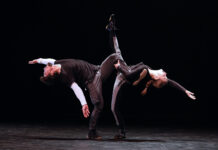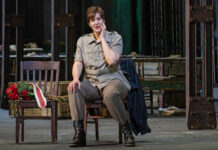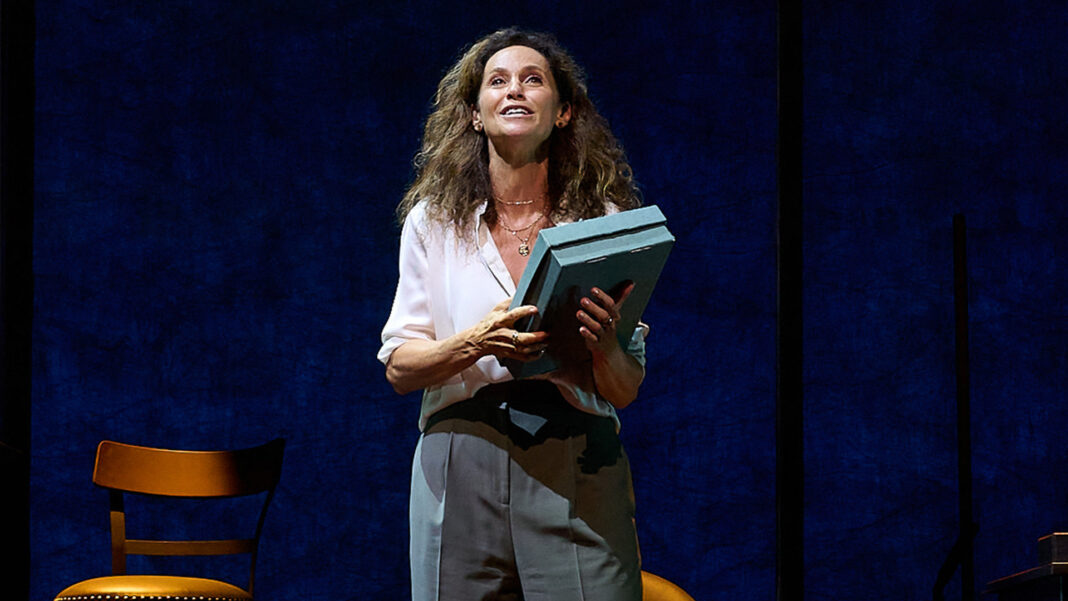Actress Amy Brenneman is probably best-known for two long-running television series: Judging Amy and Private Practice. But she’s spent quite a bit of time on stage. One of her earliest stage roles was as Elizabeth in Shakespeare’s Measure for Measure in 1983. She’s appeared in Rapture, Blister, Burn and The Power of Sail at the Geffen Playhouse more recently.

Brenneman is currently appearing in Adam Rapp’s The Sound Inside at the Pasadena Playhouse. She plays Bella, a 50-something university professor battling cancer who strikes up an unconventional relationship with one of her writing students (Anders Keith). This isn’t an exploration of sexual dynamics the way David Mamet did in Oleanna. Rather it is the gradual revealing of layers about who these two people are and what they need/want from life at this exact given moment in time.
Cameron Watson directs the play which continues at the Pasadena Playhouse through October 1st.
In one of the last weeks of rehearsals, I spoke with Brenneman about the play, her approach to Bella and the role of fiction in all of our lives. What follows are excerpts from that conversation that have been edited for length and clarity.
Q: The title of the play comes from a line that Bela writes over and over again, “Listen to the sound inside.” What does that title mean to you?
The circumstances of my life are very different from Bella’s and I don’t have the decisions that she has to make. But I feel a lot of kinship with her. I feel like at a certain point in life, or maybe always, the most difficult thing for me to do is to hear my own voice and hear my own instinct. We are bombarded by other people’s opinions when we’re growing up, our parents’ voices in our heads, what other friends are doing and now with social media. It’s quite difficult. But I think that is the way forward with authenticity for individuals – certainly for myself. So when I get to that part in the play, I cheat. Well, she takes me on a ride the whole time. I just go on this magic carpet ride. But literally at that moment, I try to listen to my next impulse.
Something we should probably all do on a more regular basis than we do.
Exactly. There’s always moments, and certainly this is the circumstance of this play, when we are out of bounds of anything we’ve known before. Or there’s no rules, there’s no clear path. What am I supposed to do? Well, you can do this, you can do that. But you have to listen to your own truth and it does take practice.
Adam Rapp gave an interview where he talked about how another actress had been going down this path with him before The Sound Inside was ever produced, but when she saw the “sea of words” that were in front of her, she stopped instantaneously because of the sheer volume of it. What are the challenges for you and how do you tackle this sea of words that Adam Rapp has given you?

First of all, they’re great words. It’s a well-written play. When I have an underwritten or poorly written role, I have to put on my writer’s hat even if I don’t change the words. How to make it work. How to make it palatable. It’s the opposite. There’s an abundance. I literally said to my husband this morning, it just keeps unfolding. It’s like this Christmas tree where there’s more and more gifts. Rather than thinking it’s my role, how do I make it mine?
In terms of the actual memorization, it’s a bear, but it’s all I need to move my body. That’s the other thing. I record the whole thing myself, just reading it, and then I just listen to it over and over. There are chunks to her story that are pretty distinctive, but it’s a supremely articulate play because she’s a very articulate person and I get very inspired by those kinds of words.
And you speak, at times, directly to the audience.
I love breaking the fourth wall. I feel really confident and excited about creating a relationship with each audience. I love it. As a person that’s lucky enough to go back and forth in different acting mediums, I’m always thinking what can this medium do that that medium can’t do, right? The main juicy thing that we get to do is establish a living connection with the audience and just say, I’m on stage. You’re in the audience. Hello? And Bella literally does that [in] the first line of the play. So I find just the meta of that absolutely delicious.
Bella describes herself as the equivalent of “a collector’s plate mounted on a wall.” You learn that she has far more than that over the course of the play. But if that’s one of the first hints as to who this woman is, what does that give you as a launchpad for the arc that you can build with this character?
She described herself as mediocre. She described herself as unremarkable. She is a world of all sorts of things. But then she has the cover, right? She has this job. She has students. It’s hashtag MeToo. She has to keep herself fairly restrained for lots of different reasons. So I think one way to look at the story is she just becomes less restrained. She lets her outsides begin to match her insides and she just kind of glows from within over the course of the story.
There are multiple references to different books and different authors that are built into The Sound Inside including David Foster Wallace. I found a quote from him that I thought was apropos of this play. He said, “Fiction is one of the few experiences where the loneliness can be both confronted and relieved.” It almost sounds like he’s talking about this play.
That is an element of Bela that I don’t practice in my day-to-day life. I have a pretty populated life. Although, weirdly enough, literally this month I’m now an empty nester in my house for the first time ever. I’m not a big novel reader. I know what it is to love. If you find anybody in the world, a novelist, a movie moviemaker, who you feel understands you, it’s like, Oh, I’m not alone in the world. And it is alleviating.
But that person is not in the room with you. Bella, and probably Christopher, feel like I know I’m able to connect emotionally, right? I’m able to feel like I’m not alone because of these works of art. Then the next thing is to be with a flesh and blood human next to you and trusted.

Mary-Louise Parker, who originated the role of Bella, was doing some press for this play when it was on Broadway. She said “Apparently it’s a thriller” as if that was that wasn’t part of her thinking about what the play was. Then she said everybody has a different theory as to what happened. Is that how you view this play? Is The Sound Inside a thriller?
I love that she said it. I completely agree. I didn’t see her performance. I tread lightly on reading too much about past productions. But certainly it’s like a thriller. It’s a taut thriller. I did have a moment [when] I said to Cameron, our director, “Should I be playing this a little bit more noir? And he’s like, “Oh, get that out of your head.” I think it’s a thriller in as much as these very heightened things are discussed; things get pushed quite to the edge. You don’t actually know what’s going to happen, do you think? I know when I read it, I thought it was going to go in a certain way. Never did. So I think in that way it’s a thriller, but I think it’s more of a a beautiful unfolding.
I’m going to paraphrase something that Jesse Green of the New York Times said in his beautiful review of this play when it was on Broadway. What is the role of fiction “both the kind we read and the kind we live in our world today?”
I think, in this moment of alternate truth and alternate reality, people are spinning lots of stories all the time. We’re in a time of constant storytelling and remaking and rebranding. To the point where it’s like what is the truth? We’re in this moment.
Bella starts the whole story with her memory of helping her mother die. I’ve suffered three illnesses. I have not had cancer, nor did I really look at mortality in the eye, but I was sick. And I think that the body is the truth, right? I think Bella is in her body, which is failing her, and she can tell all sorts of stories to herself. But she knows what’s going to happen. She lived it. So what I love to ponder is that fiction only lives in our imagination and in our minds. But the body is living in a much more elemental, grounded way.
Main Photo: Amy Brenneman in The Sound Inside (Photo by Mike Palma/Courtesy Pasadena Playhouse)











